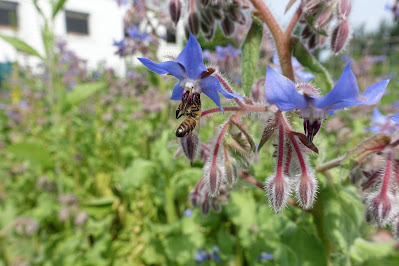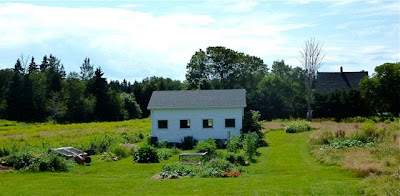Yet I still plant it each and every year. Not in my flower beds, but in my vegetable garden. Not that these starry blue flowers wouldn't be at home in any flower bed. Woven through other plants the bright spots of blue (and sometimes pink) flowers are eye catching, and the soft silver coloration of the leaves provides a welcome and interesting foliage addition. Personally though I like to plant it in large clumps. This year I have one such clump on the far edge of the small vegetable garden. Another large clump is smack dab in the middle of my tomatoes.
There's a reason for this. Some of you may be aware that borage is edible. Flowers make a pretty garnish on drinks and desserts. Flowers and leaves can be steeped for tea. You can cook the leaves like a green, or even make soup. There are plenty of medicinal properties as well. Borage is classed as a herb and can be used in poultices and salves.
I've tried eating it and wasn't too fussed honestly. The plant has fine prickly hairs from tip to toe and I didn't particularly like that texture. What I really love about borage is what it does for my other plants. It attracts pollinators.
If you have a vegetable garden you want to make sure that your plants get pollinated. I have found over the years that bees love borage and will visit my garden in droves when I plant it. Subsequently they venture into my tomatoes and do some good work there. By planting borage I ensure good pollination of my crops and provide a healthy food source for bees. Since borage doesn't bloom in one quick explosion, it also means that insects are able to find food all summer long. A mass of plants provides flowers over a two or three month span in my climate.
One downside as a seed collector is that seed ripens very haphazardly. Some is ready to drop while other flowers are just starting to bloom. For the home gardener it means that borage will spread on its own and you will never be without plants if you grow it once. The seedlings are easy to spot with their large silver leaves so if you don't like volunteers they are relatively easy to pull.










